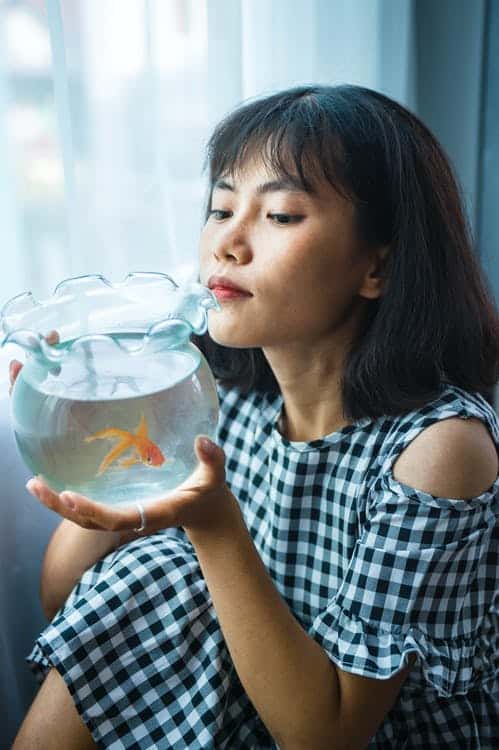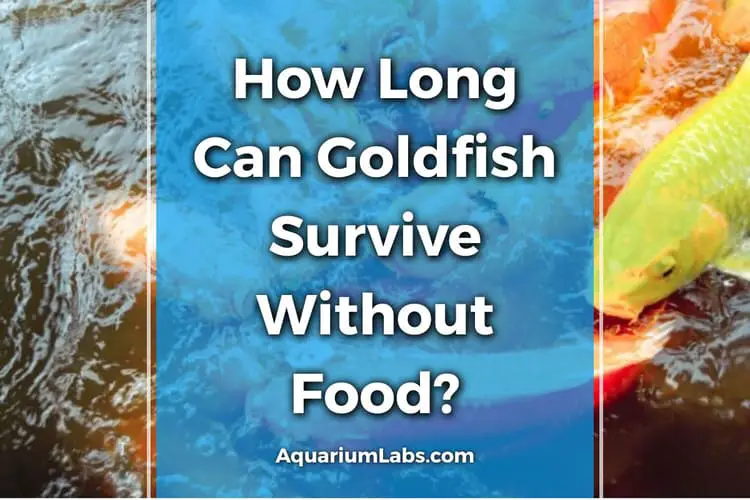Fishkeeping means that we need to care for our goldfish companions a few times per day with nutritious meals. Feeding is the best part of keeping goldfish and other fish; the energy with which they attack their meals never fails to bring a smile to one’s face.
But what if you need to take a short or long trip? Should you rely on weekend feeders or will they get by without for a few days? How long do goldfish live without food, anyway? I’ll be answering these questions and more in the following article!
How Long Do Goldfish Live Without Food?
Goldfish can be stressed by prolonged hunger but will survive for a long time, up to two weeks, in fact. So if your goldfish go without food for just a few days while you take a short trip, you don’t have to worry about them starving. You will come home to happy goldfish swimming about, hungry but healthy!
Their bellies might be a little slim since their digestive system will be empty, and they may have even used up some stored fat. But they won’t be harmed by the brief lack of food. Extended or repeated periods of no food can lead to health problems, however. You may see your goldfish become extremely skinny and start developing secondary diseases like ich or bacterial infections if they don’t get enough food. So always feed your fish just the right amount! How much should you feed your fish? Don’t worry; we’ll get to that in just a bit!
What Do Goldfish Normally Eat?

In the wild, goldfish eat constantly. They spend most of their time rooting along the bottom, hoping to dig up worms, snails, soft plants, algae, and other sources of food in the substrate. Any source of fresh organic matter is an excellent goldfish food. Goldfish go without food for extended periods since food is scarce in the wild, so you don’t have to be concerned if they miss a feeding here and there.
Keeping goldfish in outdoor ponds allows them to supplement their floating pellets with many natural options like insect larvae and algae. Pond goldfish tend to be more robust and vibrantly colored for this reason! They are also much more likely to breed in the spacious environment a pond offers. And if you can provide a selection of live plants for them to eat and breed within, so much the better!
Offering Prepared vs Fresh Foods for Goldfish
When looking to feed your goldfish, you’ve likely started to wonder what food is best to offer them. There are so many kinds of good food out there that the variety can be dizzying! Fortunately, as I’ve said before, goldfish are hearty omnivores. You can feed them just about anything so long as you give them plenty of variety!
Dried food has the benefit of being more convenient to offer and much easier to store. This includes prepared options like feed pellets, flakes, and freeze-dried items. But they aren’t as nutritious or complete as fresh foods like blood worms, brine shrimp, or plant matter. Prepared options are usually floating food, which allows it to stay readily available – and even be removed if it’s clear your fish are no longer hungry.
Meanwhile, feeding fresh foods offers your goldfish more variety and access to trace nutrients missing in the starch and grain-heavy formulas used in prepared foods. But they do decay, so you’ll need to keep them refrigerated or frozen. Goldfish gel food is a happy middle ground but still needs to be refrigerated and goes bad after a couple of weeks.
How Much Should You Feed Your Goldfish?
How much food to offer in a feeding depends on what your particular goldfish require. Are they small, young goldfish? If so, then they will need to be fed two to three times per day. Larger adult goldfish need less food. Once or twice per day is enough for them.
The tricky part is recognizing that most goldfish will continue eating even if they are full. Their instinct is to eat whenever food is available since you never know when you might go a long time between feedings in nature. You can gauge how much to feed by seeing how responsive they are. Hungry goldfish are aggressive eaters, often splashing at the top in eagerness. But they relax once they are mostly full, still eating but at a slower pace.
Water temperature is also important to feeding goldfish. Unlike tropical fish, goldfish prefer being kept in cool, temperate conditions. The temperature should be kept below 73 degrees, which moderates their metabolism and appetite. Goldfish kept at a tropical water temperature tend to need more food; as a result, eating more since they are more active in warm conditions. That said, fancy goldfish do enjoy slightly warmer environments since they are exclusively tank-raised, unlike common goldfish.
Should I Skip Feedings Sometimes?

It’s always a good idea to skip feeding every few days. Fish simply aren’t as active as they normally would be in their natural habitat. They can get fat and unhealthy, just as we can, from the lack of activity, and calorie restriction helps maintain proper health. Skipping an occasional feeding every few days also allows the digestive tract to empty fully and prepare itself for future meals.
If you don’t want to skip a feeding, then you can also offer small meals sometimes. The exact amount of food depends again on your goldfish and their habits. But by now, you likely have an expert’s understanding of how much your goldfish usually eat!
Less food in the tank also ensures your water quality remains pristine. Fish waste and uneaten food directly contribute to ammonia levels in the tank. This is a major problem if you have several other goldfish rather than just one or two goldfish. A heavily populated tank needs careful attention when it comes to food because a single overfeeding can lead to extremely high ammonia levels, which are fatal for goldfish.
Solutions for Unavoidable Vacations
Sometimes a multiple-day trip is unavoidable. But you need not feel tied to your aquarium, never taking a vacation to ensure your fish have enough food. So how can you feed goldfish when you aren’t around to do so?
Using an Automatic Fish Feeder
The best solution for an extended holiday is to use an automatic fish feeder. Automatic feeders can be programmed to dispense a certain portion size or weight of food into the aquarium on a customizable feeding schedule. You can set the feeding schedule to once per day, several times per day, and even skip meals or days as needed if you know what your goldfish truly need.
Most automatic feeders can be used with goldfish flakes, pellets, or any other prepared food that you have in stock. Most need to be either plugged in or run via battery power.
Slow Release Fish Food
Sometimes an automatic feeder isn’t right for certain setups. Perhaps you don’t have enough electrical outlets for another device. Or maybe you don’t trust automatic feeders. In that case, you can try using slow-release fish food! These are pressed blocks of nutrition that appear to be hard as stone when purchased from the pet store.
Once they hit the water, though, they slowly absorb moisture, softening and crumbling so your fish can nibble away at them as needed. Slow-release formulas are typically designed to completely decay in either 3 days or 14 days, which are common vacation times.
Given how inexpensive and uncomplicated they are, slow-release vacation feeders are a great way to keep your goldfish from going without food while you’re gone. But they do have a major downside you should be aware of.
Slow-release vacation feeders are continually in contact with the water and releasing food. This means that they are also a constant source of water pollution since decay-causing bacteria will also consume the nutrients. Excess food can cause your aquarium ammonia levels to become elevated in just a short time.
If your filtration is adequate and you don’t have too many fish, there should be no problem. But a tank with a heavy bioload may see water quality issues while you’re away, which is the worst time for an ammonia spike since you can’t perform a water change. Also, the nutritional value of slow-release formulas isn’t the best. But they are better than no food at all.
Hiring a Fish Sitter for your Goldfish
A fish sitter is an even better solution than an automatic fish feeder for several reasons. Once they know how much food to feed your goldfish, fish sitters can adjust that amount as need if they see your fish aren’t hungry. Fish sitters can also report to you if they see signs of disease, a lack of appetite, or poor water quality, which automatic feeders can’t do.
It’s best to choose a neighbor or friend that has experience in fishkeeping. People unfamiliar with goldfish are much more likely to offer too much food or misinterpret any veterinary advice you give if a disease issue arises. If a filter needs adjustment or a water change is required, that’s not likely to be something they can do over the phone.
Live Plants for Goldfish
Goldfish not only enjoy animals but plants for food as well. Aquatic plants provide several benefits: food and a source of oxygen, cover for security, and a place for fish to spawn. As egg scatterers, goldfish naturally seek out thickets of aquatic weeds when they are mature and willing to breed!
Live plants also use ammonia, nitrite, and nitrates as fertilizer, absorbing them and preventing goldfish from being stressed by these compounds. They fuel plant growth, which in turn, can be eaten by your goldfish.
The best plants for goldfish are softer plants that can be easily torn and chewed. Elodea is very popular for this reason. It can also grow as a floating plant, which is perfect since your goldfish are likely to uproot it from the gravel as they pluck leaves from the plant. Cabomba is another excellent choice that’s even more beautiful, though it’s picky when it comes to lighting and does much better in outdoor ponds that get full sun.
Conclusion
Goldfish go without food regularly in nature, and they will do just fine with a missed meal here or there. Most fish keepers actually should skip feedings sometimes as it’s healthier for them, just as it is for us.
But if you’re going away for a long period, then it’s best to ensure your goldfish don’t go without food the entire time. Automatic feeders, slow-release fish food, fish sitters, and live plants are the best options for ensuring your goldfish don’t go without.
And if it’s a short trip of a few days or less, you need not worry. You’ll come home to some hungry but still very healthy goldfish!
Related Fishkeeping Question:


